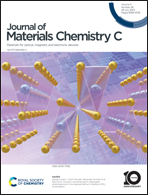Spirofluorene-locked carbazole based multiple resonance thermally activated delayed fluorescence emitters for efficient solution-processed narrowband green OLEDs†
Abstract
Two kinds of multiple resonance thermally activated delayed fluorescence emitters namely SpDCz and DSpDCz are developed for solution-processed narrowband green organic light-emitting diodes (OLEDs) by fusing spirofluorene-locked carbazole moieties into the periphery of a boron, nitrogen-doped polycyclic aromatic hydrocarbon skeleton. Compared to the parent polycyclic aromatic skeleton with blue emission, SpDCz and DSpDCz exhibit longer emission wavelengths in the green region (λem = 498–505 nm) owing to the extended frontier molecular orbital distributions on the spirofluorene-locked carbazole moieties. Meanwhile, the photoluminescence quantum efficiency of the MR-TADF emitters is retained at up to 97–99% in solid-state films owing to the suppressed non-radiative transitions of excited states by the rigid and locked orthogonal configuration between outer carbazole and the polycyclic aromatic skeleton. Solution-processed OLEDs employing DSpDCz bearing two spirofluorene-locked carbazole moieties as emitters exhibit pure green electroluminescence at 505 nm with a FWHM of 31 nm and CIE coordinates of (0.13, 0.62), together with a maximum external quantum efficiency of 19.0%, representing a promising device efficiency for solution-processed narrowband green OLEDs.



 Please wait while we load your content...
Please wait while we load your content...